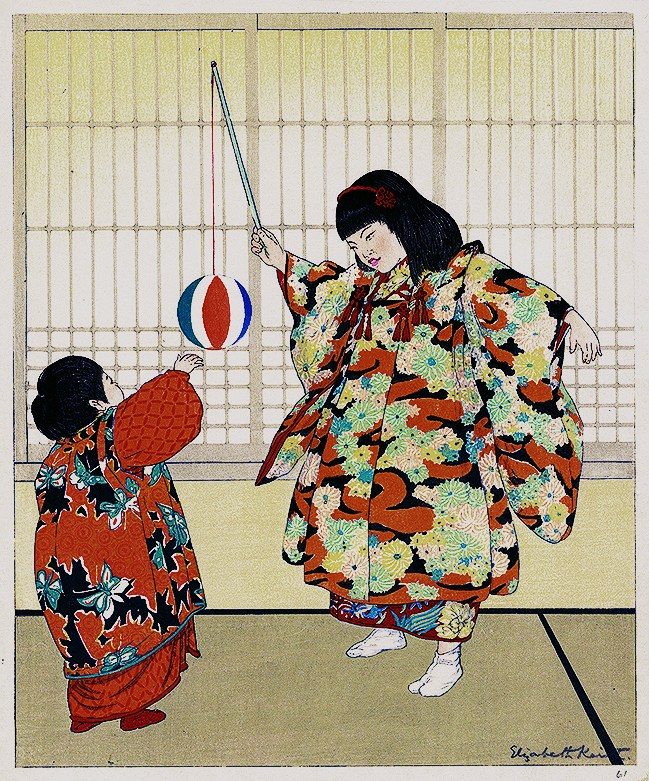Japanese Children of Yesterday is a color woodcut created in 1925 by Elizabeth Keith. An alternate title is Two Little Girls Playing Ball. It is pencil signed within the image in the lower right. Japanese Children of Yesterday was printed by Watanabe on Japanese laid hosho. The edition was projected at 100 but never completed. The reference is Miles 106 and the image measures 13-9/16 x 11-1/4 inches.
In her woodcut, Japanese Children of Yesterday, Keith depicts two Japanese children dressed in traditional, intricately patterned kimonos, playing with a kamifusen, a delicate, hollow paper balloon made of colored wax paper. The older girl appears to be teasing the younger child with a kamifusen dangling from a stick but perhaps she instructing the child how to bounce it off the palm of her hand to keep it inflated. Keith rendered the background in neutral tones. A soft golden light filters through shoji screens focusing the attention on the vivid kimonos and colorful balloon.
Elizabeth
Keith, watercolorist, illustrator, and printmaker, was born in
Aberdeenshire, Scotland on 30 April 1887. When her family moved to London, she
grew increasingly distant, choosing to spend her time drawing. Despite her lack
of formal art education, she developed into a talented watercolorist and began
cultivating an interest in Asian culture, which was still relatively new to
Westerners at the time. When her sister, Jessie, married J. W. Robertson Scott,
a Tokyo publisher with New East Press, she traveled with them to Japan in 1915 intending
it to be a short visit. Keith remained in Japan for nine years. She drew
inspiration from the landscape, temples, and daily life, sketching her
surroundings constantly.
In 1917, the Peer’s Club of Tokyo asked Scott to produce a book to raise money
for the Red Cross. Working with Keith, Scott reproduced sixty-two watercolors
portraying sardonic caricatures of Tokyo’s social luminaries in a book titled Grin
and Bear It, and held a promotional exhibition of the original paintings.
Although many of the figures represented in the book were infuriated, Keith
gained significant attention for her artistry. The publisher Shōzaburō Watanabe
saw her work and became interested in collaborating with Keith. His workshop
translated her watercolor into the color woodcut East Gate, Seoul by Moonlight. This led to several collaborations
between 1919 and 1922 and, although almost all of her prints were executed at
Watanabe’s traditional shin-hanga
workshop, Keith participated in every part of the process and even carved some
of her own blocks. She depended upon Watanabe for the production and
distribution of her artwork.
In 1928, Keith published the diary of her travels in the book Eastern Windows, complete with sketches. She returned to Asia and Japan twice more before World War II. As a printmaker and watercolorist, she gained an international reputation and exhibited to great acclaim in Britain and the United States. In 1933, Keith began mastering the techniques of color etching and continued to produce prints from sketches she had made in Asia.
After her last visit to Japan, Keith returned to London in 1936 and continued exhibiting until pre-war tension in Japan forced her to cancel her shows. The market for Asian-influenced art completely deteriorated and by the late 1930s Keith was no longer able to support herself with the sale of her work. Despite the virtual abandonment by collectors and friends, Keith continued painting and making prints of the landscapes and people she loved, and during the war she raised funds for Chinese women affected by Japan's military violence. In 1946, she and Jessie published Old Korea: Land of the Morning Calm, a celebration of the country and people who had welcomed them throughout the 1920s and 1930s. The book included criticism of Japan's colonization of Korea before and during the war.
Keith exhibited with the Royal Institute of Painters in Watercolour, the Royal Academy, the International Society, and the Royal Society of Artists. Her work is represented in the collections of the Dayton Art Institute, Ohio; the Jordan Schnitzer Museum of Art, University of Oregon, Eugene; the Honolulu Museum of Art, Hawaii; the British Museum, London; the Metropolitan Museum, New York; the National Gallery of Canada, Ottawa; the Musée Guimet, Paris; the Rhode Island School of Design Museum, Providence; the McNay Art Museum, San Antonio, Texas; and the Fine Arts Museums of San Francisco, California.
Elizabeth Keith died in London, England in 1956.



